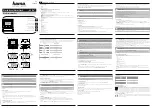
DS12885/DS12887/DS12887A/DS12C887/DS12C887A
Real-Time Clock
____________________________________________________________________
19
Update Cycle
The device executes an update cycle once per second
regardless of the SET bit in Register B. When the SET
bit in Register B is set to 1, the user copy of the double-
buffered time, calendar, and alarm bytes is frozen and
does not update as the time increments. However, the
time countdown chain continues to update the internal
copy of the buffer. This feature allows time to maintain
accuracy independent of reading or writing the time,
calendar, and alarm buffers, and also guarantees that
time and calendar information is consistent. The update
cycle also compares each alarm byte with the corre-
sponding time byte and issues an alarm if a match or if
a don’t-care code is present in all three positions.
There are three methods that can handle RTC access
that avoid any possibility of accessing inconsistent time
and calendar data. The first method uses the update-
ended interrupt. If enabled, an interrupt occurs after
every update cycle that indicates over 999ms is avail-
able to read valid time and date information. If this
interrupt is used, the IRQF bit in Register C should be
cleared before leaving the interrupt routine.
A second method uses the update-in-progress bit (UIP)
in Register A to determine if the update cycle is in
progress. The UIP bit pulses once per second. After
the UIP bit goes high, the update transfer occurs 244µs
later. If a low is read on the UIP bit, the user has at least
244µs before the time/calendar data is changed.
Therefore, the user should avoid interrupt service rou-
tines that would cause the time needed to read valid
time/calendar data to exceed 244µs.
The third method uses a periodic interrupt to determine if
an update cycle is in progress. The UIP bit in Register A
is set high between the setting of the PF bit in Register C
(Figure 3). Periodic interrupts that occur at a rate greater
than t
BUC
allow valid time and date information to be
reached at each occurrence of the periodic interrupt.
The reads should be complete within one (t
PI/2
+ t
BUC
)
to ensure that data is not read during the update cycle.
Handling, PC Board Layout,
and Assembly
The EDIP module can be successfully processed
through conventional wave-soldering techniques so long
as temperature exposure to the lithium energy source
does not 85°C. Post-solder cleaning with water-
washing techniques is acceptable, provided that ultra-
sonic vibration is not used. Such cleaning can damage
the crystal.
SELECT BITS
REGISTER A
RS3
RS2
RS1
RS0
t
PI
PERIODIC
INTERRUPT
RATE
SQW OUTPUT
FREQUENCY
0
0
0
0
None
None
0
0
0
1
3.90625ms
256Hz
0
0
1
0
7.8125ms
128Hz
0
0
1
1
122.070µs
8.192kHz
0
1
0
0
244.141µs
4.096kHz
0
1
0
1
488.281µs
2.048kHz
0
1
1
0
976.5625µs
1.024kHz
0
1
1
1
1.953125ms
512Hz
1
0
0
0
3.90625ms
256Hz
1
0
0
1
7.8125ms
128Hz
1
0
1
0
15.625ms
64Hz
1
0
1
1
31.25ms
32Hz
1
1
0
0
62.5ms
16Hz
1
1
0
1
125ms
8Hz
1
1
1
0
250ms
4Hz
1
1
1
1
500ms
2Hz
Table 3. Periodic Interrupt Rate and
Square-Wave Output Frequency
UIP
UF
PF
t
BUC
= DELAY TIME BEFORE UPDATE
CYCLE = 244
μ
s
1 SECOND
t PI
t
P1/2
t
P1/2
t
BUC
Figure 3. UIP and Periodic Interrupt Timing




































